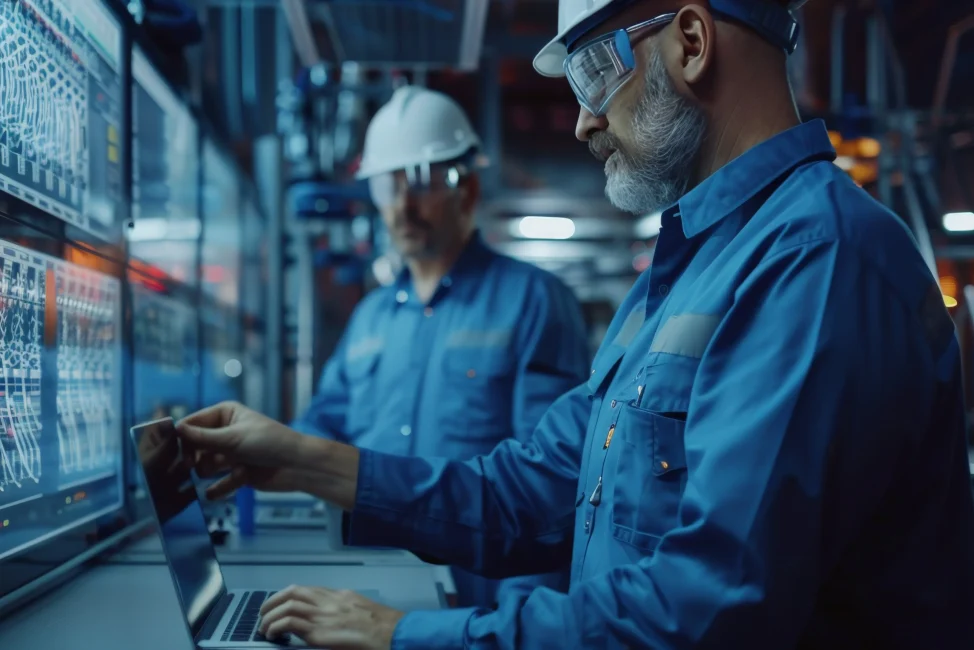Energy companies no longer treat artificial intelligence (AI) as something optional for their process optimization. Just the opposite, they are in a hurry to adopt it as they see what a transformative impact it offers. As Deloitte states, 44% of energy organizations consider AI indispensable for their future operations.
Indeed, AI systems unlock multiple optimization options for such a massive industry as energy. AI enables insights into weather data, supply and demand fluctuations, equipment health, and more. With all this information, companies can disrupt how their businesses operate and unlock new opportunities for customers. So, let’s take a look at the use cases, benefits, and adoption challenges of AI in energy.
The Utilization of AI in the Energy Industry: Prominent Use Cases
Artificial intelligence offers a number of valuable benefits to the energy sector, ranging from consumer-focused solutions such as smart homes to critical use cases like predictive maintenance. Below we provide a few real-life applications of AI.
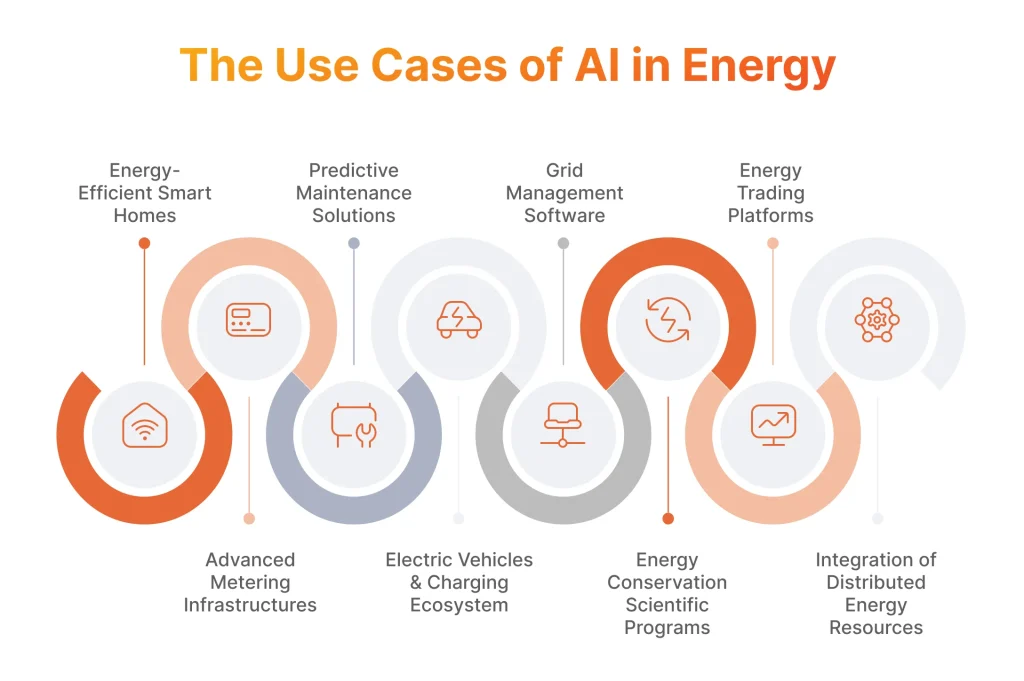
Energy-Efficient Smart Homes
Xcel Energy, a major US-based utility company, offers their customers a program that involves rebates on the purchase of smart thermostats and letting the company adjust the thermostat settings. This program is specifically designed to manage peak energy consumption during the hottest and coldest days of the year.
With AI capabilities integrated into thermostats, this program allows the company to learn user schedules and climate control preferences. Xcel Energy collects that information to use for automatically adjusting heating and cooling. In such a way, the business stabilizes the electrical grid by reducing energy generated during peak periods and adjusts to the demand while avoiding the high costs associated with generating or purchasing additional electricity.

Serhii Leleko
AI&ML Engineer at SPD Technology
“The usage of artificial intelligence in such a way also helps in meeting regulatory requirements and environmental goals by reducing overall energy consumption and promoting energy efficiency. This aligns with sustainability initiatives and reduces greenhouse gas emissions.”
Predictive Maintenance Solutions
Siemens provides companies with a predictive maintenance solution that is based on AI-enabled analytics. This solution predicts potential breakdowns of equipment and aids enterprises to limit unplanned downtime and optimize maintenance plans.
With such a predictive maintenance solution powered by machine learning and artificial intelligence, energy companies can predict when machines need to undergo maintenance outside the schedule. This is done by analyzing data from several sources, including sensors that measure equipment temperature, vibrations, and pressure. This strategy lowers repair costs and increases the longevity of equipment, in addition to improving equipment reliability.
SPD Technology also delivered a custom AI-powered predictive maintenance system for one of our clients. It is designed for monitoring electricity consumption to anticipate and prevent equipment failures. This predictive maintenance solution has become a part of a larger energy management infrastructure and helps our clients achieve increased operational efficiency due to timely maintenance alerts and optimized resource allocation.
Grid Management Software
Another AI solution for energy corporations by Siemens is a SaaS for better low-voltage grid transparency. It introduces smart grids that monitor, manage, and optimize the production and distribution of electricity. Siemens’ solution works by building a digital model of the grid by utilizing existing data. This method makes it possible to track its status, identify crucial sections, and simulate changes to the grid.
Such a system helps grid operators analyze smart grids’ data to forecast possible problems, improve energy distribution, and ensure grid stability. Plus, energy firms can enhance their departmental decision-making by utilizing the actionable insights offered by similar grid management platforms.
Automated Energy Trading Platforms
Flexitricity, a company that specializes in demand response aggregation, integrated AI into their platform to adopt such capabilities as optimizing energy trading and grid stability. Thanks to the business impact of Big Data, enterprises can now collect and analyze information on every process. Flexitricity also gains insights from multiple data sources, including historical market prices, weather forecasts, and consumption patterns, to come up with energy price predictions. This enables the company to make informed and, what’s important, profitable trading decisions.
Because of this, trading choices can be automated by the platform, guaranteeing that energy is bought and sold at the best moments to secure earnings. Furthermore, the platform can modify demand response plans in real time to balance the grid’s supply and demand.
Advanced Metering Infrastructures (AMI)
Due to powerful data analytics, the solution called IBM Watson IoT for Energy brings energy companies the possibilities to optimize their grid operations and asset management. The technology helps utilities optimize energy supply and demand, cutting waste and improving grid dependability, by collecting and analyzing real-time data from smart meters.
Some companies’ smart grid management relies heavily on this IBM technology, with the example of Red Eléctrica, a Spanish power transmission company. Utilities can dramatically increase overall grid resilience, prolong asset lifespans, and enhance maintenance efficiency with AI-generated insights into equipment health and performance.
Electric Vehicles (EVs) and Charging Infrastructure
AI is used in Tesla’s Superchargers to optimize and manage the allocation of charging loads. With the help of this cutting-edge technology, power is dynamically distributed throughout the network, saving consumers’ wait times and improving the effectiveness of charging processes.
Tesla’s AI system is capable of forecasting spikes in demand and modifying the allocation of electricity by examining real-time data on vehicle arrivals, charging status, and station occupancy. Ensuring that more cars can be charged more quickly contributes to preserving grid stability.
Energy Conservation Scientific Programs
As a part of research efforts, DeepMind, a technology development company that also conducts machine learning and neuroscience studies, developed AI-powered advanced energy conservation techniques. Those assist in improving cooling systems. As a prime result of their work, Google’s data centers leveraged these techniques and actually saved a great amount of electricity. For that, AI continuously evaluates current environmental variables and past data to forecast the most effective cooling tactics.
This method has achieved a 40% reduction in the energy used for cooling, which has led to cost savings and a minimized carbon impact. The AI system independently modifies the cooling parameters to guarantee peak efficiency.
Integration of Distributed Energy Resources (DERs)
AutoGrid, a company specializing in AI-driven systems for grid optimization and DER management, establishes Virtual Power Plant (VPP) platforms. These VPPs are aggregations of several DERs and combine multiple energy resources such as batteries, solar panels, and electric cars.
The VPP performance is optimized by AutoGrid’s AI. The whole VPP working process is based on variables including grid circumstances and electricity costs and ensures the increase of earnings for companies using them by taking part in energy markets and grid services. One example is AutoGrid’s partnership with community choice aggregators in California, which controls grid congestion and incorporates renewable energy via VPPs.
The Perspectives of Generative AI in the Energy Industry
Among all the technologies enabled by AI, generative AI is one of the most commonly adopted by companies in different sectors, including energy. The matter is that generative AI offers unprecedented potential to optimize the design of energy systems, enhance decision-making regarding resource and electricity consumption, and lessen the negative impacts on climate. Let’s explore the emerging trends of Generative AI in the energy industry.
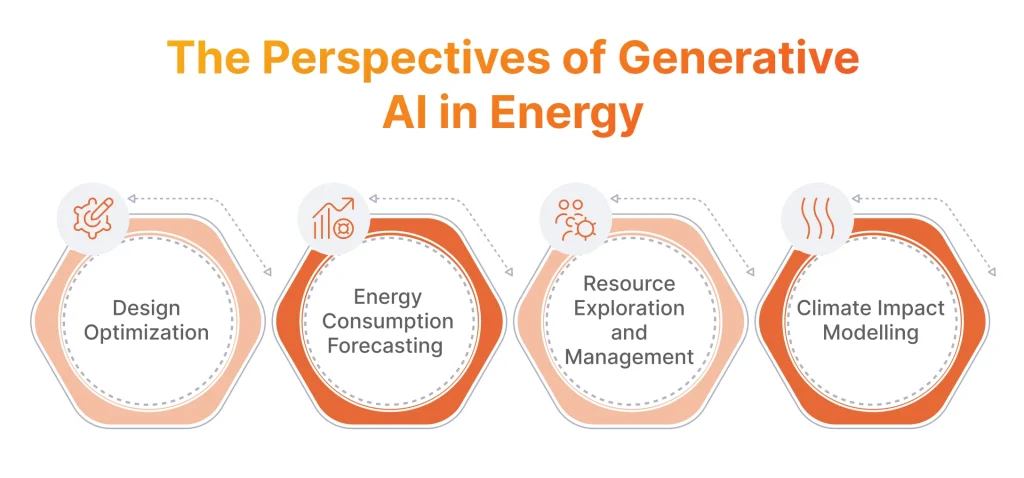
Design Optimization
With Generative AI, the energy sector gains the opportunity to simulate a wide range of design parameters and configurations for future equipment development. Thanks to the ability to analyze tons of information, AI algorithms determine which design options are the most safe and productive for specific energy equipment tasks. Generative AI development helps to design an AI system that will offer insights into building not only traditional assets but also sustainable energy equipment, including:
- Solar panels;
- Energy storage systems;
- Hydroelectric turbines
- Wind turbine blades;
With generative AI, it becomes possible to elevate equipment manufacturing. The technology shortens the time it takes to develop new products thanks to rapid prototyping and routine task automation.
Looking to learn more about the use of AI in manufacturing?
Check our dedicated article on how AI shapes the present and future of the manufacturing industry!
Energy Consumption Forecasting
By examining past energy usage data and weather patterns, generative AI is particularly good at estimating energy demand and supply trends. With the help of these estimates, energy providers can optimize supply, cut costs and waste. Also, precise forecasts of demand contribute but are not limited to the following opportunities:
- Balancing the grid;
- Ensuring a stable energy supply;
- Minimizing the need for emergency measures during peak times.
In addition, AI-powered forecasts can help with strategic choices like whether to implement demand-response plans or increase the production of green energy. Besides, using generative AI for sustainable energy forecasting can lead to a more sustainable energy system.
Resource Exploration and Management
Generative AI can also provide precise subsurface models for resource exploration. Those models generated in high resolution will highlight where to uncover untapped resources and help evaluate their feasibility by examining geological data. Such use of artificial intelligence, enhances the identification of the sites for:
- Drilling for oil, gas, and geothermal energy extraction;
- Mining for coal, metals, and minerals;
- Sustainable energy installation;
- Carbon capture and storage.
Generative AI can make environmental stewardship and planning simpler, leading to resource development with lasting ecological and economic benefits.
Climate Impact Modelling
The use of Generative AI can contribute to generating scenarios for predicting greenhouse gas emissions and mitigating climate change. AI and machine learning models help energy firms understand the potential environmental consequences of their actions to:
- Develop effective climate policies;
- Set realistic emission targets;
- Track progress towards sustainability goals.
Climate impact modeling is exceptionally beneficial to the food sector as well. With the use of AI, it is possible to predict with precision how climate change will impact food supply networks, animal production, and agricultural harvests. AI in the food industry is often used to simulate different climate scenarios and help farmers adapt to possible droughts, floods, and severe temperatures.
The Challenges of AI in the Energy Sector
While artificial intelligence can facilitate the work of energy firm staff, many companies may still find it difficult to adapt to AI-driven industrial processes. At this point, businesses can consider the advantages of strategic technology consulting or conduct their own research to prepare for this change. Below, we provide the most common challenges of adopting AI in energy sector.
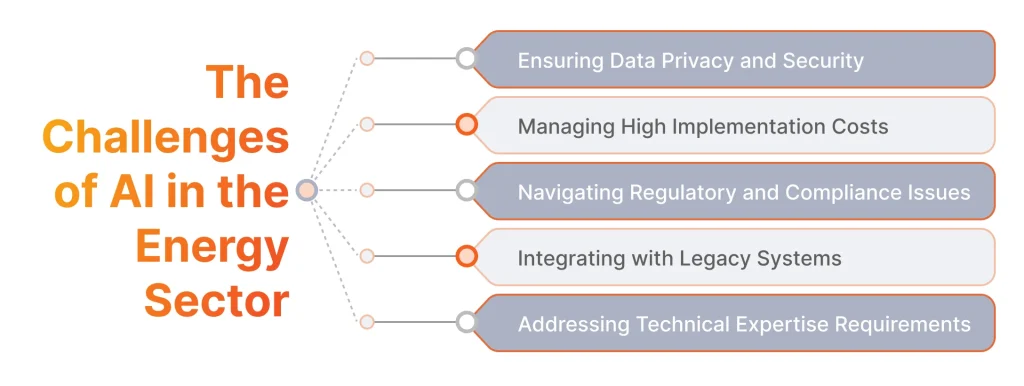
Ensuring Data Privacy and Security
Statista conducted a survey and found out that 20% of respondents were most concerned about data breaches and exposure of sensitive data because of generative AI. However, it is impossible to make the most out of AI without training ML models on data. Therefore, safeguarding data from cyberattacks is crucial. To protect the energy sector from security breaches, it is essential to set up robust encryption, secure data storage, and turn on access controls.

Serhii Leleko
AI&ML Engineer at SPD Technology
“It is also advisable to conduct security audits and penetration testing of your AI system to identify and address potential threats. Plus, companies must incorporate anonymization and de-identification techniques to protect sensitive information.”
Managing High Implementation Costs
It is reported that businesses spent around 154 billion U.S. dollars on AI systems across all industries in 2023. Indeed, AI solution development and implementation need a large portion of investments in advanced hardware, infrastructure, and trained professionals. Buying equipment, obtaining software licensing, and integrating AI systems with current processes are among the initial costs.
The financial load is further increased by ongoing expenses for updates, training, and maintenance. To properly manage these costs, businesses must carefully assess the return on investment and take into account scalable or phased implementation options.
Since AI is advancing at a faster rate than most regulations adapting to it, its implementation leads to uncertainty in terms of compliance problems. To make sure your energy company does not break any rules, you must comply with rules regarding data usage, environmental impact, and operational requirements. Some of the most crucial data protection regulations are GDPR or CCPA, and it is impossible to implement AI in energy industry without them.
Our team prioritizes the importance of ensuring the safety and privacy of customer data. We have already ensured GDPR, PCI DSS, OFAC, and HIPAA compliance for a range of projects and can navigate complexities connected to such requirements.
Integrating with Legacy Systems
In the Statista survey concerning the main reasons for companies to modernize their legacy systems and data, 46% of respondents replied they need better integrations with modern technologies. Indeed, AI is one of the leading innovations to date, and many enterprises need it integrated into their systems.
However, numerous energy infrastructures are built on legacy technology, and it takes a lot of work to re-engineer processes, update hardware, and create new interfaces in order to ensure a smooth AI integration. Moreover, it takes considerable time to move to the cloud computing infrastructure. Yet, it is required for smooth operations of AI-enabled energy systems. All these efforts frequently require specific knowledge, careful planning, testing, and gradual implementation.
Addressing Technical Expertise Requirements
The energy industry’s embrace of AI is challenged by the talent gap. While AI offers great potential, 68% of executives state it is difficult to find qualified personnel with the necessary data science, machine learning, and domain expertise combined.
Therefore, there are two ways to overcome the problem: either to train your internal personnel to build their AI development skills or hire external data scientists, software and machine learning engineers to bridge the skill gap and ensure a smooth AI adoption.
Our team has experience in creating AI-powered platforms for the industrial sector. We leveraged multiple ML algorithms to create predictive maintenance, defect detection, and user guidance capabilities for the equipment inspection system. The result of our efforts is improved inspector safety, automated task completion, and reduced maintenance costs.
The Future of AI in the Energy Industry
The transformative impact of artificial intelligence on the energy sector is undeniable right now. What’s more, AI is projected to bring even more advantages in the future. Let’s take a look at the potential applications of AI.
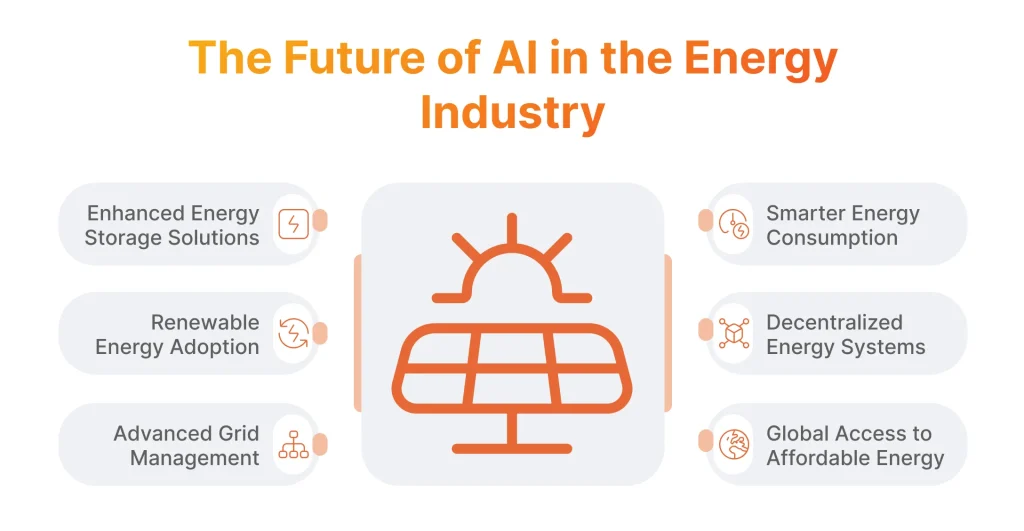
Increased Integration with Renewable Energy
The global market for AI in renewable energy was valued at USD 10 billion in 2022. It is projected to exceed USD 114.87 billion by 2032, growing at a CAGR of 27.70% from 2023 to 2032. No wonder companies use AI for green energy as it has the potential for optimizing energy generation and distribution from wind, solar, and hydroelectric sources.
In the near future, AI will bring us even more capabilities to examine inputs from satellites, sensors, and weather monitoring stations to anticipate solar radiation and wind speed. All that big data that goes through analytics will allow for forecasting the supply of clean energy generation more accurately.
Advanced Grid Management
The task of maintaining grid stability is one for which AI is especially well-suited. This is because AI can learn from vast volumes of data and respond to complex grid issues scenarios. The future promises us advanced grid management and, thus, an improved energy infrastructure thanks to AI-powered computer vision development.
Computer vision systems with cameras installed on the vehicles will gather data, geolocating each pole and taking high-resolution pictures. Then, object detection capabilities in such systems along with ML-powered anomaly detection will spot any issues with the grid and alert energy providers to resolve them. In such a way, energy companies will be able to maintain uninterrupted grid management processes.
Enhanced Energy Storage Solutions
Battery technology and other cutting-edge solutions that store energy will be optimized primarily by AI as this technology is capable of forecasting patterns in energy production and consumption. That means AI can help them optimize the longevity and efficiency of storage systems.
This makes it possible to integrate intermittent sustainable energy sources, which include wind and solar, to improve the storage of excess energy during times of peak production, and release during times of high demand. Thus, companies will guarantee a steady supply of electricity.
Smarter Energy Consumption
Advanced analytics and intelligent automation that are possible thanks to AI can make energy consumption more customer-centric and cost-conscious. It is achieved thanks to AI-driven insights for adjusting the electricity usage of consumers according to their consumption trends. At the same time, demand response management programs powered by AI have the potential to encourage customers to cut back on electricity use during peak hours. Hence, it can guarantee the sustainability and stability of the grid as a whole.

Serhii Leleko
AI&ML Engineer at SPD Technology
“By aligning energy consumption with availability, these technologies not only save costs but also support the integration of clean energy sources, furthering the goal of a sustainable energy future.”
Decentralized Energy Systems
AI will lead an energy toward decentralized systems, in which power generation and storage will rely on community microgrids and household solar panels. In other words, energy systems will be separated among many smaller units.
AI is capable of managing such decentralized systems through the optimization of energy flow, local supply and demand balancing, and grid integration. Equipped with these decentralized processes, companies will achieve a more sustainable energy environment. At the same time, they will strengthen the resilience of energy flow.
Affordable Energy and Global Access to It
When it comes to cutting operational costs, AI is also helpful because of its ability to optimize production thanks to intelligent automation and error-free generated insights. In its turn, it could lead to a global decrease in the cost and increase in accessibility of energy.
AI can also predict energy output and manage microgrids. With this done, it promotes deploying green energy in underserved and remote places, bringing dependable, sustainable power where it was previously nonexistent.
Conclusion
Despite the energy sector still gearing towards the massive adoption of AI, the technology already offers numerous benefits to energy companies. The main advantages of AI in energy include setting up energy-efficient smart homes, allowing predictive maintenance for equipment, and supporting industrial processes with grid management software. Other benefits offered by AI encompass better EV infrastructure, enhanced energy storage solutions, and affordable energy for many customers globally.
AI not only helps enhance energy production and distribution, but it also aids energy firms in developing AI-driven designs for equipment, making electricity usage forecasts, enabling resource exploration, and modeling climate impact.
While the adoption of AI is essential for the energy industry, this process isn’t ultimately straightforward and affordable. Companies still struggle to ensure data privacy, design AI systems that are compliant with regulations, or integrate AI components into legacy platforms. Yet, it is important to overcome these challenges as AI can offer even better integration with sustainalbe energy, more powerful grid management, smart energy storage, and decentralized energy systems.
So, if you need to elevate how your energy enterprise operates and accommodate the needs of customers, get in touch with our engineers for the latest AI development expertise.
FAQ
What Is the Role of AI in the Energy Sector?
AI in energy sector optimizes energy production, distribution, and consumption. It helps in forecasting energy demand, enhancing grid management, improving energy efficiency, and facilitating the integration of sustainable energy sources. AI also supports predictive maintenance, reduces operational costs, and enables the development of smart grids.
What Are the Benefits of Using AI in Energy Management?
Using AI in energy industry for management brings improved energy efficiency, reduced operational costs, and enhanced grid stability. AI provides accurate energy demand forecasts, optimizes energy distribution, and enables real-time monitoring and control of energy systems. Additionally, AI facilitates the integration of renewable energy sources, enhances predictive maintenance practices, and supports data-driven decision-making.
How Can Energy Companies Successfully Integrate AI into Their Operations?
Energy companies can successfully integrate AI by first assessing their specific needs and identifying areas where AI can add value. They should invest in AI training for their staff, collaborate with technology experts, and adopt a phased implementation approach. On top of that, strategic technology consulting can help navigate integration challenges.
How AI Is Used for Predictive Maintenance in Energy Facilities?
AI analyzes data from sensors and monitoring systems to predict potential equipment failures. ML algorithms detect patterns and anomalies in the data, providing early warnings and actionable insights. Such an approach minimizes downtime, reduces maintenance costs, and extends the lifespan of equipment.
How Can AI Help In Renewable Energy?
AI in energy industry can significantly enhance clean energy generation by optimizing the performance and integration of sustainable sources like wind, solar, and hydro. It enables precise forecasting of energy production based on weather data, improving grid stability and energy storage management.

